Bonsai Trees
Case Histories
Dwarf Cedar of Lebanon - (cedrus libani nana)
Cedar Bonsai Style: Literati
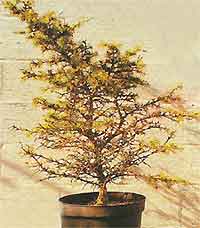
This cedar is the second of the pair and I have developed it into a very different tree. It was a much bigger tree than the other, with an excellent base and a single thick trunk. Being a dwarf variety and therefore slow growing, this tree must have taken many years to attain this trunk girth and overall size.
The best viewing angle was easily apparent, showing a good trunk line and branch arrangement. After establishing for a year to regain strength, the next summer I first removed all the dead branches and reduced the height, using a suitable side branch to form a new leader. The two main branches were very flexible and with strong wire applied I was able to bend and twist them downwards considerably.
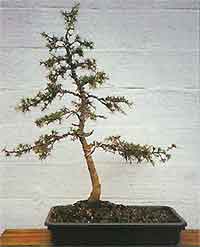
A problem with the structure became obvious - there was no suitable back branch low down. The only solution that I could see was to use a shoot from the main right-hand branch to extend behind the tree, dividing this branch into two and giving the impression of another separate branch.
I was happy with the overall shape and thought that this was one day going to make a good bonsai.
Cedar Bonsai History: Training
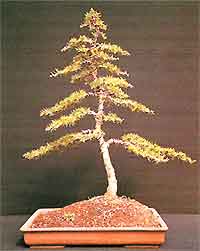
When I removed the cedar from its flower pot in the spring, I found more dead roots than live ones. I pruned off all the dead roots and left everything that looked healthy. The tree responded well and by late spring looked delightful, being covered in its fresh new foliage.
That year, my relative inexperience at the time became clear, when I realised that I had potted the cedar towards the wrong side of the pot and the overall image was unbalanced. As the weight of the trunk was predominantly to the left, it should have been potted slightly to the right. This was corrected the following year and the cedar was planted in its first bonsai pot.
Three years later after annual repotting, I realised that the tree was too wide and drastically reduced the width of most branches to make it appear taller with more depth. This was a definite improvement and a smaller pot was chosen. I lived with this new shape until the summer when I studied the tree further.
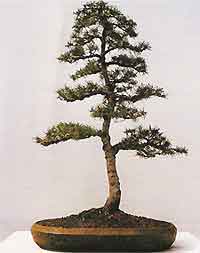
The bottom branches with the lack of a 'real' back branch were certainly the problem, and I remembered the words of a fellow bonsai enthusiast - 'If you have a problem, cut it off. Then you don't have that problem anymore!'
After serious thought and confident that the cedar would make a good literati style tree, I took a deep breath and removed the lowest three branches, leaving behind small, stubby jins. Several branches were also cut off nearer the top to lighten the foliage masses and provide important areas of space. The tree was now completely three dimensional and at last I was happy with this new pine-like image. Several branches were wired and a smaller, round pot was selected for the spring.
The next year, in its new pot, the cedar began to look glorious. After extensive root pruning it continued to grow well. I completely structured and wired all of the branches, thinning them out as I went and removing downward pointing needles. Feeding was reduced to minimise growth and I felt that this tree had finally 'arrived'. At this stage it was exhibited for the first time and I was pleased that I had found the courage to radically re-style my cedar and improve its appearance so much.
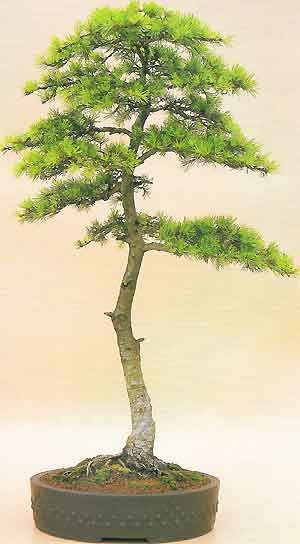
 This cedar is the second of the pair and I have developed it into a very different tree. It was a much bigger tree than the other, with an excellent base and a single thick trunk. Being a dwarf variety and therefore slow growing, this tree must have taken many years to attain this trunk girth and overall size.
This cedar is the second of the pair and I have developed it into a very different tree. It was a much bigger tree than the other, with an excellent base and a single thick trunk. Being a dwarf variety and therefore slow growing, this tree must have taken many years to attain this trunk girth and overall size. A problem with the structure became obvious - there was no suitable back branch low down. The only solution that I could see was to use a shoot from the main right-hand branch to extend behind the tree, dividing this branch into two and giving the impression of another separate branch.
A problem with the structure became obvious - there was no suitable back branch low down. The only solution that I could see was to use a shoot from the main right-hand branch to extend behind the tree, dividing this branch into two and giving the impression of another separate branch. When I removed the cedar from its flower pot in the spring, I found more dead roots than live ones. I pruned off all the dead roots and left everything that looked healthy. The tree responded well and by late spring looked delightful, being covered in its fresh new foliage.
When I removed the cedar from its flower pot in the spring, I found more dead roots than live ones. I pruned off all the dead roots and left everything that looked healthy. The tree responded well and by late spring looked delightful, being covered in its fresh new foliage. The bottom branches with the lack of a 'real' back branch were certainly the problem, and I remembered the words of a fellow bonsai enthusiast - 'If you have a problem, cut it off. Then you don't have that problem anymore!'
The bottom branches with the lack of a 'real' back branch were certainly the problem, and I remembered the words of a fellow bonsai enthusiast - 'If you have a problem, cut it off. Then you don't have that problem anymore!'